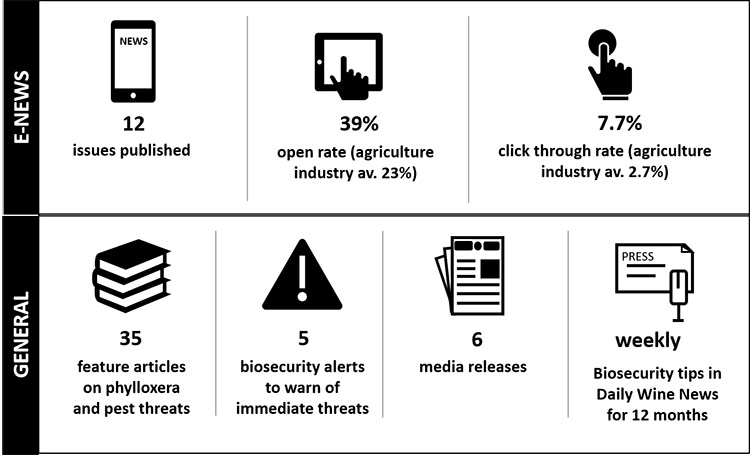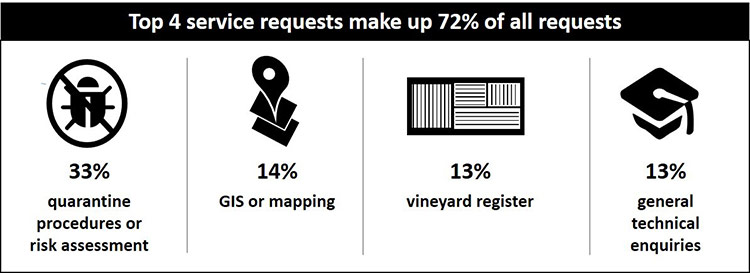Vinehealth Australia’s 2017/18 Annual Report is now available, and is packed with information about the organisation’s activities and performance to provide for the protection of vineyards from disease and to assist and support the grape industry in South Australia.
We fulfil our role by driving biosecurity for the grape and wine industries through assessing risk, responding to pest threats, participating in national and state policy development, undertaking education and awareness, surveillance, research and development priority setting and emergency response activities.
We undertake these activities to ensure the prosperity and growth of South Australia’s grape and wine industries, the people it directly employs, those employed across its supply chain, regional communities and the burgeoning wine tourism sector.
Operations and initiatives reported in the Annual Report by Strategic Plan Priority include:
- Response activities in relation to suspected endemic and exotic pests.
- Work in relation to the SA Plant Quarantine Standard.
- The project to develop the DNA method of phylloxera detection.
- The Responsible Visitation Campaign.
- Maintenance of the SA Vineyard Register.
- The Vintage Toolkit.
- Surveillance activities for phylloxera and other pests and diseases.
- Development of the Digital Biosecurity Platform.
- Management of the Naracoorte Heat Shed.
- Provision of assistance to the grape and wine industries.
- How science has been translated into practice for industry.
Two examples of information covered in the report are:
STRATEGIC PRIORITY 1: STRENGTHEN THE WINE INDUSTRY’S CAPACITY AND CAPABILITY TO PREPARE FOR, PREVENT AND RESPOND TO PEST INCURSIONS
Initiative 1: Improve phylloxera and general biosecurity awareness and education
Vinehealth’s communication and engagement implementation plan is targeted to support the delivery of the strategic plan and ensure that compelling content is delivered to all stakeholders in effective ways to:
- Excite growers about vineyard hygiene practices and to increase the number of growers implementing these practices.
- Improve compliance with state-based quarantine regulations.
- Encourage growers to regularly inspect their vines and seek help to confirm any unusual symptoms or pests.
- Ensure stakeholders understand and value Vinehealth’s activities and services.
Vinehealth has invested heavily in improved communication and engagement since 2016, and results are positive. This investment continues in 2018-19 with a clear focus on improving the implementation of farm gate hygiene practices by growers and compliance with state quarantine standards by all industry stakeholders.
The percentage of growers implementing farm gate hygiene practices was assessed in May-June 2018 via a survey of South Australian Vineyard Owners. This has given us baseline adoption statistics. We will survey vineyard owners again in future years. This will enable us to track changes in the number of growers implementing farm gate hygiene practices.
A refresh of Vinehealth’s website was completed in January 2018, with a new structure implemented and new content generated to increase usability. We will continue to measure website usage statistics in 2019.
Monthly e-news editions continue to be well received by an expanding subscriber list. The average open rate is just under 40%, which is well above industry average.
Refer https://vinehealth.com.au/category/news/ for details of all communication.
Continued investment in communication capability and capacity
May 2017 – April 2018.

STRATEGIC PRIORITY 4: BUILD A MATURE BUSINESS MODEL FOR VINEHEALTH AUSTRALIA
Initiative 12. Provision of assistance to the grape industry
During 2017-18, Vinehealth continued to be responsive to requests from industry within the remit of our Act. Activities related to these requests included:
- Provision of aggregated, de-identified analysis of data within the Vineyard Register to meet specific requests (all activities are in accordance with Section 13(3) of Act).
- Provision of buffer zone maps to PIRSA for fruit fly management.
- Assistance to growers, wineries and contractors to interpret state Plant Quarantine Standards, entry conditions and the completion of associated documentation.
- How to manage phylloxera infected vineyards interstate and precautions to take if working between phylloxera zones.
- Provision of best practice farm-gate hygiene tools, checklists, signage and disinfestation kits.
- Discussion with individuals about virus testing and trunk disease testing and management.

The Annual Report is based on a standard government template that we are obliged to use. While we understand the presentation isn’t engaging, we encourage you to read the Annual Report which is available here: https://vinehealth.com.au/wp-content/uploads/2018/08/VHA-annual-report-2017-18.pdf. Next year, we will create an Annual Report Snapshot to convey key information in a more engaging way.